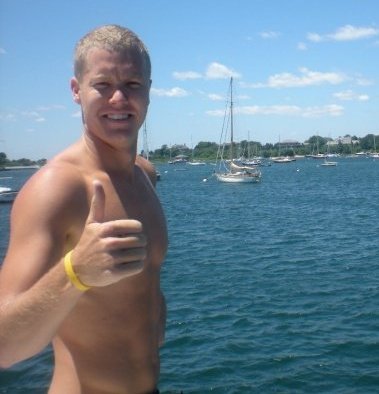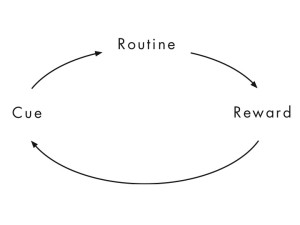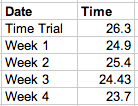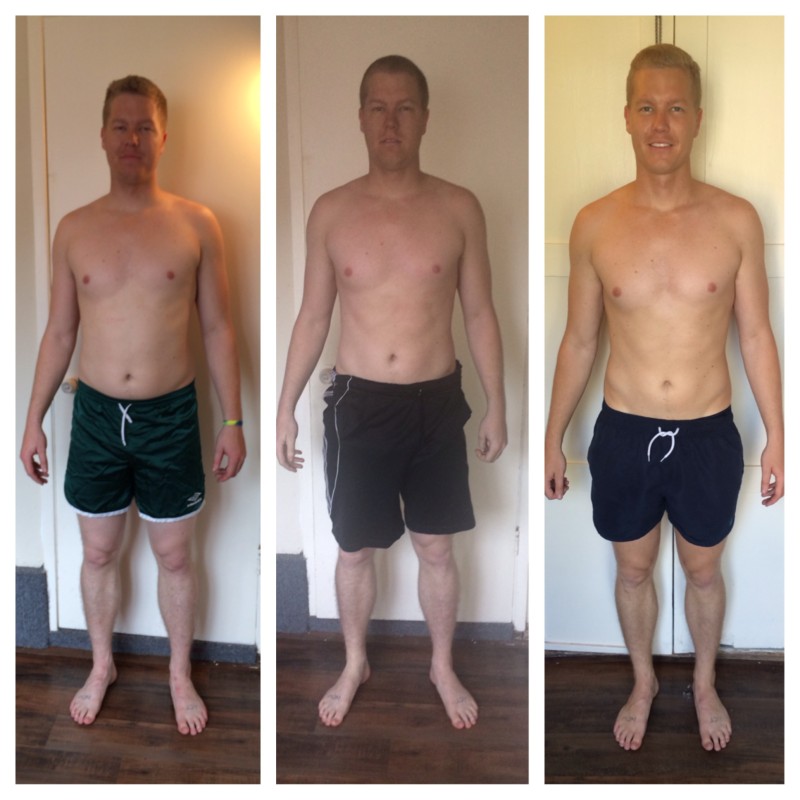I didn’t wanna post this because shirtless photos can come off douchey, but I think my experience can help others, so here goes…
A video summary of this post
***Update***
It’s June 11th and my weight today is 185…which means I’m lost 22 pounds since I started this post. I’ll update this more to show how, but here’s a photo to prove it!

I lost 13 pounds in 30 days. Here’s how:
Believe it or not I used to be pretty freakin’ fit:

Because I was a track athlete in high school and college I had a pretty good routine: lift weights in the morning, class in the afternoon, run in the evening, and race the 200m, 400m, and 4x400m on Saturday. I did this for 7 years. But when I entered the startup world my habits changed: work at a desk, eat all the snacks I want, and TONS of beer.
This made me blow up to a beautiful 211 pounds:

But after using The Power of Habit I was able to lose 13 pounds in 3 weeks, improve my 200m time by nearly 4 seconds, improve my happiness and productivity levels.

I read one book per month, implement what I read, and then write about it. Follow along:[mc4wp_form]
Background: How Habits Work
Did you know that small habits dictate each and every decision you make in life?
It’s true. Just about every single choice you will make today will be based off of some type of habit you’ve developed over time.
Here’s how a habit works: It starts with a cue, followed by a routine, and ends with a reward.
Got it? Not yet? Let’s break it down:
Lab rats at MIT learned that when they heard a noise (cue), they could navigate a maze (routine) to find some chocolate (reward). Over time, as you repeat the same cue-routine-reward over and over it again the process becomes easier and easier. Eventually you don’t even think about it…it just happens. Your mind starts to automate the entire process. And this my friend is where a habit is cemented into your brain.
Here’s a little example for ya:
Remember when you were a snot nose 16-year-old and you just got your license?
If you were like me then you you had a pretty difficult time learning how to back up your 1994 Mazda Protege outta the drive way. I bet you even hit the neighbor’s fence a few times and didn’t tell em. But overtime the entire process got a little easier. After a while you could hop right in your car, put it in reverse (cue), back down the driveway without looking much (routine) and safely drive off (reward).
Whether you’re an alcoholic, obese, or an uber successful business person…the choices you made to get wherever you are today were made by a series of habits you created for yourself.

How Can I Change a Habit?
Most habits cannot be erased…but don’t worry because here’s good news: old habits can be changed and new habits can be created!
The Golden Rule of habit change is to keep the cue and keep the reward, but to change the routine.
And if your goal is to create new habits when you trigger a cue you must also trigger a craving for the reward.
Here’s an example (my favorite one from the book):
Claude C. Hopkins was one of the world’s greatest advertising men. He made Don Draper look like a punk. Around 100 years ago (prior to Hopkins) very few people owned a tube of toothpaste. This all changed in the early 1900’s when Hopkins came across Pepsodent, a nifty new toothpaste brand. You see, prior to Hopkins and Pepsodent most toothpaste didn’t have the minty taste that left a clean, tingling feeling your mouth. However, Hopkins made sure Pepsodent added in the mint taste because because he understood the cue-routine-reward loop needed to make a product a daily habit (and a big seller).
He started the loop with a cue: campaign to bring attention to a natural filmy plaque that naturally forms on people’s teeth. “Get rid of that film. Pepsodent gives you a beautiful smile!” his ads read. Once people saw Hopkin’s ads they’d rub their tongue over their teeth and feel the plaque (cue), which lead to them wanting to use toothpaste (routine), and finished with a fresh tingling in their mouth after brushing (reward).
Prior to Hopkins 7% of Americans used toothpaste…but within just one decade of Hopkin’s campaign that number skyrocketed to around 65%.
My Case Study
I’ve always been a fan of track and field. I was a 200m and 400m runner in high school and college…and I use to be pretty good! But once I left school I stopped running and well, I got kinda fat. Not like fat fat but I was no longer a fit guy. In the past when I tried to regain some of my fitness I’d start with a simple jogging routine…but the routine always fizzled out. So when I decided to read The Power of Habit I decided to apply what I learned to get into 200m racing shape.
The 200m Challenge
My goal for the month of March was to run the 200m dash in under 24 seconds. I started with a time trial on March 1st and ran time trial each Sunday to measure the results. Part of this goal meant exercising every single day and dieting 6 days a week.
Here’s a breakdown on how I created my habits:
Cue: I planned to workout every single day. To make things easier (a key to creating patterns) I decided ahead of time that I’d only do two kind of workouts and rotate every other day.
My workouts were:
1. 5x100m hill sprints. I live on a steep ass hill. One rep takes around 20 seconds. I’d run as hard as I could and slowly walk back down, which was probably 2 to 3 minutes.
2. 75 kettle bell swings. I owned a 45 kettle bell and hate going to the gym, so that’s why I chose this workout.
Routine: I tried jogging in the past but this failed miserably. Why? Because I freakin’ hate jogging. So I focused on something I loved: sprinting.
During the workouts I’d listen to my favorite podcast: WTF. Sprinting + WTF + Morning sun = an easy routine
Reward: The biggest reward was seeing improvement. I did this by running a 200m time trial every single Sunday.
Here’s how the times broke down:

I reached my goal and broke 24 seconds on the 4th week. It felt AMAZING. It took me 30 days of working out (I never missed a day) and a some not so fun dieting but the feeling of hitting a goal was amazing.
Another note about rewards:
Seeing results was my biggest motivator. Not only did I see results in my times and weight decrease, but I started penny jar to show how single workouts slowly added up to make a huge difference. Each time I went for a run I’d put a penny in the jar. Eventually I could literally see how each penny was starting to make a significant impact. After a few weeks I created 3 more penny jars for a few other life goals.

The Results
A video summary of my time trials
Insights
Be a machine: Once I made the decision to be fit there was no looking back. I have this weird theory called “The Machine.” I’ll write about it more in another post, but basically it’s the idea that it’s easier to get things done when there’s no other option. When I chose to do something I try to fully commit, never look back, and start the habit as if I’m an automated robot, hence “The Machine.”
Measure: I chose the 200m dash for two reasons. The first is running is fun for me, which made this thing way easier. The second was so I could measure everything. There aren’t too many sports where you can clearly measure improvements, but I think this is KEY. I’m not sure fi you can improve on something you can’t measure.
Small wins: Small wins were one of the biggest factor to my success. One small win will leads to another win. For example, many people claim that making their bed in the morning makes them more productive at work. Science has even proved that when you workout you are more likely to pay your bills on time and have less credit card debt. When I put a penny in the jar and saw an improvement in my time I was encouraged not only to keep on working out but to read more and work harder throughout the day.
Like what you read?
Each month I read one book and write about how I’m implementing what I learned into my daily life.
Sign up below to be notified when I write a new post:
[mc4wp_form]
Have a cool book in mind that you want me to read? Tell me in the comments section below!





Be careful with dieting.
“Diets don’t work. People who go on a diet where they eat very little will most likely lose weight. But the risks are serious. Within a few days, the body knows it is not well fed and it begins to save energy by lowering the rate at which it burns energy (metabolism). When a person begins to eat normally again, the body stores a greater amount of the food energy eaten because it is not burning as much energy, and this results in weight gain. When the weight is re-gained, the person often feels like a failure for not losing enough weight or may feel discouraged for not keeping the weight off. This is why diets don’t work.
Diets for weight loss can lead to:
low self-esteem
more weight gain due to lowered metabolism
emotional distress”
http://www.healthunit.org/nutrition/hottopics/dieting/dietfacts.htm#sthash.c4q8j7GG.dpuf
I love this post. It provides quick takeaways, as well as the underlying though process of how we are wired to help you make mental shifts needed to follow through.
I’ve followed this for one week (so far, 4 days straight), in combination of eating more consciously. Lost 5 pounds (mostly water weight) on a 150 lb body. feel great! Will let you know my results after 1 month.
Awesome post…just read The Power of habit….motivated to lose weight
Another great read!